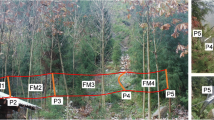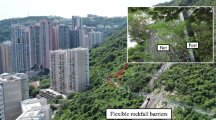Abstract
Natural hazards, such as high winds, heavy rains and ice melting, can easily trigger the rockfall which usually leads to great personal injuries and property loss; therefore, the rockfall protection is of great significance and necessity. Among the types of protection, the flexible protection occupies a beneficial condition of application. This paper indicates the basics of flexible protection which includes its classification and advantages, subsequently, analyzing the mechanism of both active protection and passive protection, and then systematically summarizing the research accomplishments, and puts forward the research direction of the flexible protection, including: (1) apart from the traditional rigid protection, the flexible protection has a wide range of advantages, which makes the flexible protection a new and effective protective structure in the rockfall protection; (2) the current researches reveal that though the scholars have done a variety of achievements of flexible protection, there is still a lack of precise simulation of the whole model and local test of the component; (3) putting forward the prospective research direction minutely in both active protection and passive protection.











Similar content being viewed by others
References
Abad MSA, Shooshtari A, Esmaeili V, Riabi AN (2013) Nonlinear analysis of cable structures under general loadings. Finite Elem Anal Des 73(73):11–19
Azzoni A, Freitas MHD (1995) Experimentally gained parameters, decisive for rock fall analysis. Rock Mech Rock Eng 28(2):111–124
Bertolo P, Oggeri C, Peila D (2009) Full-scale testing of draped nets for rock fall. Can Geotech J 46(3):306–317
Bertrand D, Nicot F, Gotteland P, Lambert S (2008) Discrete element method (DEM) numerical modeling of double-twisted hexagonal mesh. Can Geotech J 45(8):1104–1117
Bertrand D, Trad A, Limam A, Silvani C (2012) Full-scale dynamic analysis of an innovative rockfall fence under impact using the discrete element method: from the local scale to the structure scale. Rock Mech Rock Eng 45(5):885–900
Buzzi O, Spadari M, Giacomini A, Fityus S, Sloan SW (2013) Experimental testing of rockfall barriers designed for the low range of impact energy. Rock Mech Rock Eng 46(4):701–712
Buzzi O, Leonarduzzi E, Krummenacher B, Volkwein A, Giacomini A (2015) Performance of high strength rock fall meshes: effect of block size and mesh geometry. Rock Mech Rock Eng 48:1221–1231
Castro-Fresno D, Del Coz Diaz JJ, López LA, García Nieto PJ (2008) Evaluation of the resistant capacity of cable nets using the finite element method and experimental validation. Eng Geol 100(1–2):1–10
Cazzani A, Mongiovı̀ L, Frenez T (2002) Dynamic finite element analysis of interceptive devices for falling rocks. Int J Rock Mech Min 39(3):303–321
Cerro M, Giacchetti G, Lelli M, Grimod A, Arul A (2016) Hybrid rockfall barrier—new design methodology based on the Colorado full-scale test experience. In: Proceedings of the first Asia Pacific slope stability in mining conference, Australian Centre for Geomechanics, Perth, pp 393–406
Coulibaly JB, Chanut MA, Lambert S, Nicot F (2018) Sliding cable modeling: an attempt at a unified formulation. Int J Solids Struct 130–131:1–10
Del Coz Díaz JJ, García Nieto PJ, Castro Fresno D, Blanco Fernández E (2009) Non-linear analysis of cable networks by FEM and experimental validation. Int J Comput Math 86(2):301–313
Del Coz Díaz JJ, García Nietob PJ, Castro-Fresnoc D, Rodríguez-Hernándezc J (2010) Nonlinear explicit analysis and study of the behaviour of a new ring-type brake energy dissipator by FEM and experimental comparison. Appl Math Comput 216(5):1571–1582
Dhakal S, Bhandary NP, Yatabe R, Kinoshita N (2012) Numerical and analytical investigation towards performance enhancement of a newly developed rockfall protective cable-net structure. Nat Hazard Earth Syst 12(4):1135–1149
Escallón JP, Wendeler C (2013) Numerical simulations of quasi-static and rockfall impact tests of ultra-high strength steel wire-ring nets using Abaqus/Explicit. In: 2013 SIMULIA community conference, Austria
Escallón JP, Wendeler C, Chatzi E, Bartelt P (2014) Parameter identification of rockfall protection barrier components through an inverse formulation. Eng Struct 77:1–16
Escallón JP, Boetticher V, Wendeler C, Chatzi E, Bartelt P (2015) Mechanics of chain-link wire nets with loose connections. Eng Struct 101:68–87
Gentilini C, Govoni L, Miranda SD, Gottardi G, Ubertini F (2012) Three-dimensional numerical modelling of falling rock protection barriers. Comput Geotech 44(44):58–72
Gentilini C, Gottardi G, Govoni L, Mentani A, Ubertini F (2013) Design of falling rock protection barriers using numerical models. Eng Struct 50(3):96–106
Giacomini A, Thoeni K, Lambert C, Booth S, Sloan SW (2012) Experimental study on rockfall drapery systems for open pit highwalls. Int J Rock Mech Min 56(12):171–181
Glover J, Denk M, Bourrier F, Volkwein A, Gerber W (2012) Measuring the kinetic energy dissipation effects of rock fall attenuating systems with video analysis. In: 12th Congress INTERPRAEVENT, vol 1, pp 151–160
Gottardi G, Govoni L (2010) Full-scale modelling of falling rock protection barriers. Rock Mech Rock Eng 43(3):261–274
Grassl H, Volkwein A, Anderheggen E, Ammann WJ (2002) Steel-net rockfall protection - experimental and numerical simulation. In: 7th international conference on structures under shock and impact, Structures under shock and impact VII, Structures and materials, vol 11, pp 143–153
Hambleton JP, Buzzi O, Giacomini A, Spadari M, Sloan SW (2013) Perforation of flexible rockfall barriers by normal block impact. Rock Mech Rock Eng 46(3):515–526
Lambert S, Gotteland P, Nicot F (2009) Experimental study of the impact response of geocells as components of rockfall protection embankments. Nat Hazard Earth Syst 13(3):459–467
Liu CQ, Chen LY (2015) Application and study of passive flexible protective net in slope protection. Highway 6:44–50
Liu CQ, Chen LY, Chen C, Wei T (2014) Experimental study on the passive flexible protection under the rock-fall impact. Chin J Geol Hazard Control 25(4):37–44
Liu CQ, Chen LY, Chen C, Deng YX (2016a) Full scale test and fem simulation for ring-type brake energy dissipater in falling rock protection. Chin J Rock Mech Eng 35(6):1245–1254
Liu CQ, Chen LY, Qi X (2016b) Force analysis of passive protection nets with different connection modes under rockfall impact. China Railw Sci 37(2):17–25
Liu CQ, Deng YX, Wei XD (2016) The research of pre-stress calculation method in the ring-type break energy dissipater through energy principle. In: 25th National conference on structural engineering, China
Liu CQ, Tian S, Chen C, He GJ, Zhao BD (2016d) Study on the ring-brake energy dissipater in passive flexible protection. Railw Stand Des 60(9):36–41
Liu CQ, Wei XD, Lu Z, Wu HD, Yang YL, Chen LY (2017) Studies on passive flexible protection to resist landslides caused by the May 12, 2008, Whenchuan earthquake. Struct Des Tall Spec 26:e1372. https://doi.org/10.1002/tal.1372
Moona T, Oh J, Mun B (2014) Practical design of rockfall catchfence at urban area from a numerical analysis approach. Eng Geol 172(5):41–56
Nicot F, Cambou B, Mazzoleni G (2001) Design of rockfall restraining nets from a discrete element modelling. Rock Mech Rock Eng 34(2):99–118
Peila D, Ronco C (2009) Technical note: design of rockfall net fences and the new ETAG 027 European guideline. Nat Hazard Earth Syst 9(4):1291–1298
Peila D, Pelizza S, Sassudelli F (1998) Evaluation of behaviour of rockfall restraining nets by full scale tests. Rock Mech Rock Eng 31(1):1–24
Priour D (2003) Analysis of nets with hexagonal mesh using triangular elements. Int J Numer Methods Eng 56(12):1721–1733
Sasiharan N, Muhunthan B, Badger TC, Shu S, Carradine DM (2006) Numerical analysis of the performance of wire mesh and cable net rockfall protection systems. Eng Geol 88(1–2):121–132
Spadari M, Giacomini A, Buzzi O, Hambleton JP (2012) Prediction of the bullet effect for rockfall barriers: a scaling approach. Rock Mech Rock Eng 45(2):131–144
Tajima T, Maegawa K, Iwasaki M, Shinohara K, Kawakami K (2009) Evaluation of pocket-type rock net by full scale tests. Iabse Symp 10:10–19
Tajima T, Maegawa K, Iwasaki M, Kawakami K (2010) Evaluation of pocket-type rockfall protection nets using shock absorbers by full scale weight impact tests. Kozo Kogaku Ronbunshu A 56:1088–1100
Thoeni K, Lambert C, Giacomini A, Sloan SW (2013) Discrete modelling of hexagonal wire meshes with a stochastically distorted contact model. Comput Geotech 49(4):158–169
Thoeni K, Giacomini A, Lambert C, Sloan SW, Carter JP (2014) A 3D discrete element modelling approach for rockfall analysis with drapery systems. Int J Rock Mech Min 68(2):107–119
Thompson AG, Villaescusa E, Player JR, Morton EC (2013) Rock support mesh responses to static and dynamic loadings, Rock dynamics and applications - State of the art, 1st international conference on rock dynamics and aplications, pp 537–542
Tran PV, Koji M, Saiji F (2013) Experiments and dynamic finite element analysis of a wire-rope rockfall protective fence. Rock Mech Rock Eng 46(5):1183–1198
Tran van P, Maegawa K (2012) Experiments and numerical modeling of a rockfall protective wire rope fence. Int J GEOMATE 2(2):219–226
Volkwein A, Schellenberg K, Labiouse V, Agliardi F, Berger F, Bourrier F, Dorren LKA, Gerber W, Jaboyedoff M (2011) Rockfall characterisation and structural protection—a review. Nat Hazard Earth Syst 11(9):2617–2651
Wang M, Shi SQ, Yang YK, Luo X (2010) Mechanical analysis of the resistant capacity of cable nets in the active protection systems. J Logist Eng Univ 26(3):8–12
Wyllie D, Shevlin T, Glover J, Wendeler C (2017) Development of design method for rockfall attenuators. In: 68th Highway geology symposium, Georgia
Ye SQ, Chen HK, Tang HM (2010) Method for calculating the impact force of falling stone. Chin Railw Sci 31(6):56–62
Zhao YN, Qi X, Yu ZX, Zhao SC (2016) Preliminary study of hybrid flexible rockfall protection het. Chin J Geol Hazard Control 27(1):111–116
Acknowledgements
The financial support from the National Natural Science Foundation of China (No. 51778538), the China Scholarship Council (No. 201707005100), and the China-Indonesia Joint Research Center for High-speed Railway Technology (No. KY201801005) are acknowledged and sincerely appreciated by the authors.
Author information
Authors and Affiliations
Corresponding author
Additional information
Publisher's Note
Springer Nature remains neutral with regard to jurisdictional claims in published maps and institutional affiliations.
Rights and permissions
About this article
Cite this article
Yang, J., Duan, S., Li, Q. et al. A review of flexible protection in rockfall protection. Nat Hazards 99, 71–89 (2019). https://doi.org/10.1007/s11069-019-03709-x
Received:
Accepted:
Published:
Issue Date:
DOI: https://doi.org/10.1007/s11069-019-03709-x




